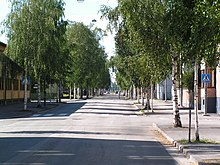Storgatan, Umeå

The eastern part of Storgatan.
|
|
| Former name(s) | Södra långgatan |
|---|---|
| Length | 4 km (2 mi) |
| Location | Umeå, Sweden |
| Coordinates | 63°49′45.63″N 20°14′10.97″E / 63.8293417°N 20.2363806°E |
| From | East |
| To | West |
| Construction | |
| Inauguration | 1622 |
| Other | |
| Known for | Its birch avenue |
Storgatan ("Main Street" or literally "Great Street") is one of the longer streets in Umeå (Sweden), about 4 kilometers long. Storgatan passes by the main city areas on the north side of Ume River. The street reaches from the old city limits at Tvärån in the west to Umeå East Station, near the Norrland's University Hospital, in the east.
Along Storgatan lies a number of Umeå Municipality's historic buildings, and five of the city's major parks. On average around 8,900 vehicles per day passes on this street (2006).
When Umeå was founded in 1622, on the northern side of the Ume River, it was staked out in a grid pattern with two longitudinal streets parallel to the river and five perpendicular alleys that ran all the way to the river. The southern long street (nowadays Storgatan) continued onwards from the city limits in the form of the coastal road that ranged between and Tornio.
The coastal road's local route went from Röbäck, to the ferry location on the Ume River at Backenkyrkan (literally "The Hillside Church"), through Umeå and then around Nydalasjön's southern tip and on to Innertavle.
In 1780, Storgatan was paved and in 1782 the houses along it received house numbers, since it was decided that all houses and farms in Umeå should be numbered. The number had to be painted on a wooden board and nailed above the main entrances.
In 1864 Umeå got a new city plan, which had influences from Nikolaistad (Now the City of Vaasa) that was rebuilt after a fire in 1852.
In this plan the width of the streets were extended. The width of Storgatan increased from about 4–5 meters to roughly 18 meters (60 feet). The new plan also made room for sidewalks and plant beddings along the street. These approximately 3 meters (10 feet) wide beddings had to be planted with flowers and shrubs at the homeowner’s expense. The house owners even got a fencing obligation, meaning that a property facing the street must be enclosed by a plank wall or fence, and it had to be built in a "tasteful" style. However those rules did not apply to already developed areas, for cost reasons.
...
Wikipedia
